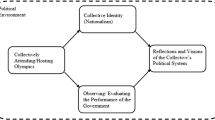Abstract
Winning medals at the Olympic Games has become an objective that countries worldwide want to achieve. In line with research devoted to the predictors of success, the present article examines the connection between certain welfare characteristics (political, social, and economic development) and the probability of success in the 1984 and 2004 Olympics. We expected to find that structural macro conditions still predict Olympic success. Using welfare indicators as formative instead of reflective indicators (Bollen, Qual Quant 183: 77–85, 1984, p. 65), the results of our Structural Equation Model reveal that both economic and social development had an effect in 1984, as well as in 2004. Political development was only significant in 1984. As for the control variables, population size was significant in both 1984 and 2004. Sporting tradition and geographical conditions had no effect at all. The model fit is very good with a chi-square of 6.62 with 5 degrees of freedom (p = 0.25).
Similar content being viewed by others
References
Baimbridge M.: Outcome uncertainty in sporting competition: the Olympic Games 1896–1996. Appl. Econ. Lett. 5(3), 161–164 (1998)
Bale J.: Sports geography. Routledge, London (2003)
Ball D.: Olympic Games competition: structural correlates of national success. Int. J. Comp. Sociol. 13, 186–200 (1972)
Bernard A., Busse M.: Who wins the Olympic Games: economic resources and medal totals. Rev. Econ. Stat. 86(1), 413–417 (2004)
Bian X.: Predicting Olympic medal counts: the effects of economic development on Olympic performance. Park Place Econ. 13, 37–44 (2005)
Bollen K.: Multiple indicators: internal consistency of no necessary relationship. Qual. Quant. 183, 77–85 (1984)
Bollen K.: Structural Equations with Latent Variables. Wiley, New York (1989)
Bollen K., Lennox R.: Conventional wisdom on measurement: a structural equation perspective. Psychol. Bull. 110(2), 305–314 (1991)
Bynner J.: Analyzing change over time using LISREL: social life and delinquency. In: Dale, A., Davies, R. (eds) Analyzing Social and Political Change. A Casebook of Methods, pp. 99–117. Sage Publications, London (1994)
Coe S.: Olympic Review: Preparing for ’88. Sports Council, London (1985)
Condon E., Golden B., Wasil E.: Predicting the success of nations at the summer Olympics using neural networks. Comput. Oper. Res. 26(13), 1243–1265 (1999)
De Bosscher V., De Knop P., Heyndels B.: De winnaar is...Rusland! [The winner is...Russia!]. In: De Knop, P., Scheerder, J., Vanreusel, B. (eds) Sportsociologie. Het Spel en de Spelers, pp. 214–230. Elsevier Gezondheidszorg, Maarssen (2006)
Diamantopoulos A.: Export performance measurement: reflective versus formative indicators. Int. Mark. Rev. 16(6), 444–457 (1999)
Freedom House.: Freedom House official Website. Retrieved June 25, 2008, from www.freedomhouse.org (2007)
Grimes A., Kelly W., Rubin P.: A socioeconomic model of national Olympic performance. Social Sci. Q. 55, 777–782 (1974)
Gruneau R.: Class, Sports, and Social Development. Human Kinetics, Champaign (1999)
Hair J., Black W., Babin B., Anderson R., Tatham R.: Multivariate Data Analysis. Prentice Hall, New Jersey (2006)
Heinilä K.: The totalization process in international sport. Sportwissenshaft 12, 235–254 (1982)
Hoare, R.: World Climate official Website. Retrieved June 25, 2008, from www.worldclimate.com (2005)
Hoffmann R., Ging L., Ramasamy B.: Public policy and Olympic success. Appl. Econ. Lett. 9(8), 545–548 (2002)
International Olympic Committee: Olympic Charter. International Olympic Committee, Lausanne, Switzerland (2004)
International Olympic Committee.: Official Website of the Olympic Movement. Retrieved June 25, 2008, from www.olympic.org (2007)
Johnson, D., Ali, A.: Coming to play or coming to win: Participation and success at the Olympic Games. Wellesley College Dept. of Economics Working Paper No. 2000–2010 (2000)
Jöreskog K., Sörbom D.: LISREL 8.70 [Computer software]. Scientific Software International, Chicago (2004)
Levine N.: Why do countries win Olympic medals? Some structural correlates of Olympic Games success. Sociol. Social Res. 58, 353–360 (1974)
Lüschen G.: The interdependence of sport and culture. Int. Rev. Sport Sociol. 21, 27–39 (1967)
MacCallum R., Browne M.: The use of causal indicators in covariance structure models: some practical issues. Psychol. Bull. 114(3), 533–541 (1993)
Maguire J.: Global Sport. Identities, Societies (1999)
Marshall M., Jaggers K.: Polity IV Project: Dataset Users’ Manual. George Mason University, Arlington (2005)
Moaddel M.: Political conflict in the world economy: a cross-national analysis of modernization and world-system theories. Am. Sociol. Rev. 59(2), 276–303 (1994)
Moosa I., Smith L.: Economic development indicators as determinants of medal winning at the Sydney Olympics: an extreme bounds analysis. Austral. Econ. Pap. 43(3), 288–301 (2004)
Rathke A., Woitek U.: Economics and the summer olympics. An efficiency analysis. J. Sports Econ. 20(10), 1–18 (2008)
Renson R.: Het relativisme van het Olympisme [The relativism of Olympism]. In: De Knop, P., Scheerder, J., Vanreusel, B. (eds) Sportsociologie. Het Spel en de Spelers, pp. 230–236. Elsevier Gezondheidszorg, Maarssen (2006)
Riordan, J., Lowe, B., & Nikishkinoy, L.: Soviet commitment and the success of the XXII Olympic Games, Moscow 1980. Review of Sport and Leisure, 521–534 (1980)
Seppänen P.: Olympic success: a cross-national perspective. In: Lüschen, G., Sage, G. (eds) Handbook of Social Science of Sport, pp. 93–116. Stipes, Champaign (1981)
Sfeir L.: The status of Muslim women in sport: conflict between cultural tradition and modernization. Int. Rev. Sociol. Sport 20(4), 283–304 (1985)
Stamm, H., Lamprecht, M.: Sydney 2000—The best games ever? World sport and relationships of structural dependency. Paper presented at the 1st World Congress of the Sociology of Sport, Seoul, Korea (2001)
Van Bottenburg, M., Wilterdink, N.: Globalization, inequality and Olympic sports successes. Paper presented at the 2004 Pre-Olympic Congress, Thessaloniki, Greece (2004)
World Bank: World Development Indicators 2003. The World Bank, Washington, DC (2003)
Author information
Authors and Affiliations
Corresponding author
Rights and permissions
About this article
Cite this article
Van Tuyckom, C., Jöreskog, K.G. C. Van Tuyckom, & K. Jöreskog, “Going for gold! Welfare characteristics and Olympic success: an application of the structural equation approach.” Quality & Quantity (in press). Qual Quant 46, 189–205 (2012). https://doi.org/10.1007/s11135-010-9351-7
Published:
Issue Date:
DOI: https://doi.org/10.1007/s11135-010-9351-7




